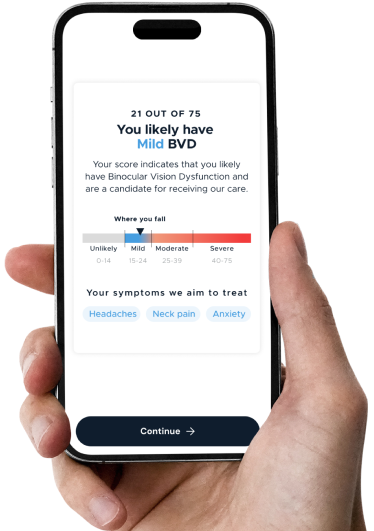Spinning, dizziness, and neck or shoulder pain may be linked to subtle eye misalignment causing eye muscle strain. This can lead to vertigo, imbalance, and chronic discomfort. Specialized prism glasses that realign vision have helped many patients find relief when other treatments failed.
Spinning, Dizziness, Neck and Shoulder Pain
It was about 12 or 14 years ago I began to experience neck and shoulder pain. My neck hurt so bad I could hardly move. I had to sleep on a special pillow. The pain was agonizing. It never stopped. I went to several doctors, and massage therapists, and an acupuncturist. Nothing helped.
Then the dizzy spells began. I couldn’t walk straight. One day I was leaving a friend’s house. As I walked into the street to get into my car, I fell and could only sit there about 4 feet from the curb with my head against my knees while everything was spinning around me. I could see nothing because it was spinning so fast. After about 10 minutes I could pull myself to the curb and waited about 5 more minutes before I could get up.
This happened sometimes when I went out for walks in the morning. The spinning would start, my arms would flail in front of me and I would collapse down onto the sidewalk until I could see again.
One morning I woke up and had to hang on to the sides of the bed while the whole room was spinning so fast I could see nothing. It would not stop. I slid off the bed and managed to slide across the floor to the phone and waited until I could see the numbers to call a friend. I had to keep my head between my knees in order to feel somewhat balanced. I crawled to the bathroom and threw up. My friend drove me down to Monroe to a chiropractor I had been seeing. I had to keep my head between my knees the whole time.
Almost every morning I had to wait until the spinning would stop before I could get out of bed.
I went to a series of chiropractors. I saw an acupuncturist, neurologist, ear, nose and throat specialist, and many doctors. I had several days of tests, xrays, MRI’s, and nothing showed up. I was told, “Well, the good news is, I can tell you what it isn’t.” I was told it was stress.
I was told it was all in my head. I was even told to go to a psychiatrist.
I was always walking off the sidewalk, three feet off the sidewalk and into walls. I fell down the stairs and sprained my ankle twice.
Twice, while driving a car, in heavy traffic the spinning began and I could not see out of the windshield. I stopped my car and just sat there while cars flew by me. I always drove in the far right lane and drove slow in case I had to pull off. I was terrified.
A friend of mine noticing the damage I was doing to myself, found an article in the Free Press about Dr. Debby Feinberg in Birmingham, specializing in Vertical Heterophoria and leader in NeuroVisual Medicine. I had never heard of this before, nor had any of the doctors I had seen. I did not believe I had this and did not believe she could help me. I had pretty much given up. The article lay on my kitchen counter for weeks. My friend kept asking me if I had called her yet. Finally, I made an appointment.
It was the most amazing thing I had ever experienced. She was the first and only person I had spoken to about this who actually knew what I was talking about. She gave me glasses with prisms in them. My neck and shoulder pain disappeared. I was no longer dizzy. I get no more spinning spells. I feel normal. I cannot imagine what my life would have been like if I had never met her.
Thank you, Dr. Debby.
-P. C., Age 54

